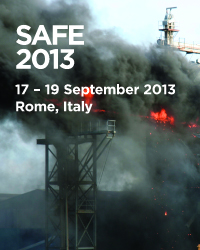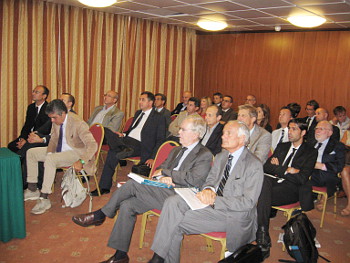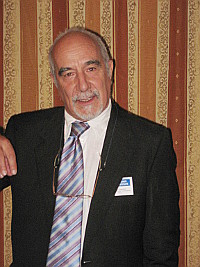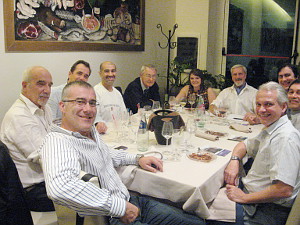5th International Conference on Safety and Security Engineering
Rome, Italy
Overview

The fifth International Conference on Safety and Security Engineering took place in Rome, organised by the University of Rome ‘La Sapienza’, represented by Prof Fabio Garzia and Massimo Guarascio, and the Wessex Institute, represented by its Director, Prof Carlos A Brebbia.
The meeting, which was very successful, follows the previous conferences held in Rome (2005), Malta (2007), Rome (2009) and Antwerp (2011).
Safety and Security Engineering, due to its special nature, represents an interdisciplinary area of research and applications that brings together, in a systematic view, many disciplines of engineering, from the most traditional to the most advanced and novel.
Safety and Security Engineering is characterised by a totally new approach since it first analyses the hazard content not only by means of technical tools but also applying risk analysis techniques, and then merges this content through technical solutions, installations, systems, human resources and proceeds to prevent or mitigate natural and man-made events that could damage people or property.
This means that Safety and Security Engineering uses a systematic and multidisciplinary approach to the safety and security problems needing to be solved, studying their reciprocal relations and interactions and finding a final optimal solution that takes into consideration all the multiple aspects in their singularity and in their belonging to a complex system. Nowadays, any context needs a safe approach that must be, from the beginning interpreted in the process to ensure the desired safety and security standards within given costs.
The Conference was opened by Prof Carlos A Brebbia, who explained the importance of the meetings to fulfil the objectives of the Wessex Institute, ie the dissemination of knowledge at an international level.
Carlos explained that the research carried out at his Institute and its application is ideally one closely related to Safety issues. The analysis technique (boundary elements) developed at WIT has shown to be of fundamental importance for extreme cases, particularly those in offshore engineering and aerospace. The work of a special unit originating in this research has centred in the applications of the techniques to problems such as corrosion and fracture, which are closely related to risk management.

Another important activity of Wessex Institute is the publication of advanced research material, through WIT Press, its associated organisation, dedicated to the production of books and journals. The output is now printed in digital as well as hard cover format. Papers presented at all WIT conferences are published in the WIT Transactions, a series that is widely distributed throughout the world and is reported in many databases. WIT Press also runs a digital library on its website, which means that the work presented at the conference is permanently and easily available to the international scientific community, (http://library.witpress.com).
Carlos finished his opening remarks by thanking all the delegates for attending the conference and hoping that they will visit the WIT campus in the future. This is sited in the New Forest National Park, which is not only very beautiful but also a most suitable place for a research institution.
Keynote Address

Massimo discussed the importance of risk indicators for social and societal engineering. He referred to ways in which the indicators could be found and presented in a case study for the L’Aquila earthquake of 2009. This emphasised the importance of predicting in research which has resulted in being able to prioritise the rescue and emergency operations.
Invited Presentations
There were a series of invited presentations by well-known colleagues, ie
- ‘A tool for intelligent budget allocation of prevention measure related to major accidents’, by Genserik Reniers, University of Antwerp, Belgium.
- ‘The management of uncertainty in quantitative risk analysis: absolute vs comparative assessment’, by Mara Lombardi, University of Rome ‘La Sapienza’, Italy.
- ‘Improved solutions for dangerous liquid containment’, by Gerardus Janszen, Politecnico di Milano, Italy.
- ‘General approach to risk optimisation of road bridges exposed to accidental situations’, by Miroslav Sykora, Czech Technical University of Prague, Czech Republic.
- ‘A statistical look at gender and age differences as related to the injury crash type on low-volume roads’, by Salvatore Biancardo, University of Naples ‘Federico II’, Italy.
- ‘Flood risk assessment and management: a case study in Rio de Janeiro’, by Marcello Miguez, Federal University of Rio de Janeiro, Brazil.
- ‘Risk occurrence measures for dangerous goods transport on a road network’, by Francesco Russo, University of Reggio Calabria, Italy.
- ‘Conceptual design of a crime regulatory system for Mexico’, by Daniel Santos-Reyes, I’CHI Research and Engineering, Mexico
- ‘Automatic human signature recognition system’, by Fabio Garzia, University of Rome ‘La Sapienza’, Italy.
- ‘Bridging the safety-security software gap’, by Warren Axelrod, Delta Risk LLC, USA.
- ‘Security procedures and devices for road transportation of high consequence dangerous goods’, by Antonella Accettura, University of Rome ‘La Sapienza’, Italy.
Conference Topics
The conference programme covered a wide range of topics, which were classified as follows:
- Risk analysis, assessment and management
- Human factors
- Incident management
- Infrastructure protection
- Construction safety and security
- Traffic safety and security
- Modelling and experiments
- Soil and food contamination
- Air pollution issues
- Air quality
- Modelling studies
- Earthquakes
Special Seminar
A special seminar was organised by Prof Antonino Vitetta of the University of Reggio Calabria on ‘Safety in the Design of Road Networks in Ordinary and Emergency Conditions’.
The seminar consisted of five specially invited papers on the following topics:
- ‘Impacts of accidents involving shopping and restocking vehicles on an urban road network’.
- ‘Risk occurrence measures for dangerous goods transport on a road network’.
- ‘A day-to-day experiment on an urban road network in ordinary and emergency scenarios’.
- ‘A before-after analysis for the design problem on an urban road network’.
- ‘Planning instruments in Italy and the UK: private and public spaces for emergency events in urban areas’.
Special Message from Dr K Duncan
A special message from Dr Kirsty Duncan, a member of the International Scientific Advisory Committee of SAFE was played during the meeting.
Kirsty, who is currently a member of the Canadian Parliament, as well as a Professor at Toronto University, could not attend the conference but was kind enough to record a DVD message to the delegates.
Kirsty referred to the importance of economic losses due to disasters in the last decade or so and to the many people affected by them. She particularly discussed the challenge facing us due to climatic changes which has aggravated the number of disasters and extreme events costs. It is essential to plan for Disaster Risk Reduction in this changing scenario. We need to aim for a disaster-resilient world and learn how to protect our homes and livelihoods and property. The time for action – Kirsty insisted – is now.
Social Occasions

The International Scientific Advisory Committee met over dinner to review the conference and propose ways to improve the meeting. The list of topics was discussed and new ones proposed. The discussion then centred on reconvening the conference in 2015 and on possible locations. The meeting also considered the publishing programme of the International Journal of Safety and Security Engineering and the possibility of having special issues to enhance the appeal of the publication.
The Conference dinner took place in a Sardinian restaurant where the delegates had occasion to taste some of the unique dishes from that part of Italy, accompanied by good local wines. The friendly atmosphere and the good service helped to make that a unique occasion.
Closing of the Conference
The Conference was closed by Carlos thanking the participants for having come and hoping that they will consider participating in SAFE 2015 which will take place in the New Forest, home of the Wessex Institute.
He also stressed that all papers published in the WIT Transactions on the Built Environment, vol 134, 2013, are now available for the scientific community through the WIT Press website (http://library.witpress.com), as well as widely distributed through the world. He invited the participants to extend their papers and submit the new versions to the International Journal of Safety and Security Engineering.
Carlos also invited delegates to participate in a post-conference semimar to take place after lunch. The seminar was on ‘Local transport plan’. It was organised by Prof Antonino Vitetta from the University of Reggio Calabria with the participation of a series of distinguished speakers, including members of the Italian Parliament, representatives of the National Council of Engineers, the Italian-Automobile Club, the Ministry of Public Works, as well as Prof Francesco Russo, from the University of Reggio Calabria, member of the Italian Commission for Forecasting and Mitigating Major Risks.
The guidelines for network analysis and local transport plans included the following topics:
- Evaluation methods
- Analysis methods
- Signal setting at local level
- Signal setting at regional level
- Layout design
The seminar added to the success of the conference.
Conference Proceedings
The proceedings of SAFE 2013 - Safety and Security Engineering V, 900pp (Print ISBN: 978-1-84564-744-5; eISBN: 978-1-84564-745-2) are available from WIT Press. Orders can be placed on the WIT Press web site at www.witpress.com or by email: This email address is being protected from spambots. You need JavaScript enabled to view it., telephone: +44 (0) 238 029 3223 or fax: +44 (0) 238 029 2853.
Papers from the conference will also be hosted online at the WIT eLibrary as Volume 134 of WIT Transactions on the Built Environment (ISSN: 1746-4498, Digital ISSN 1743-3509). For more details visit the WIT eLibrary at http://library.witpress.com


 Wessex Institute
Wessex Institute